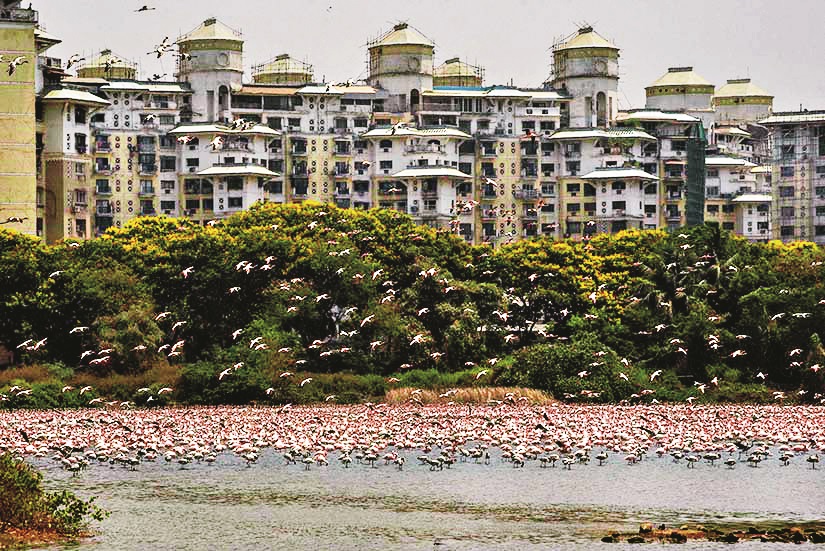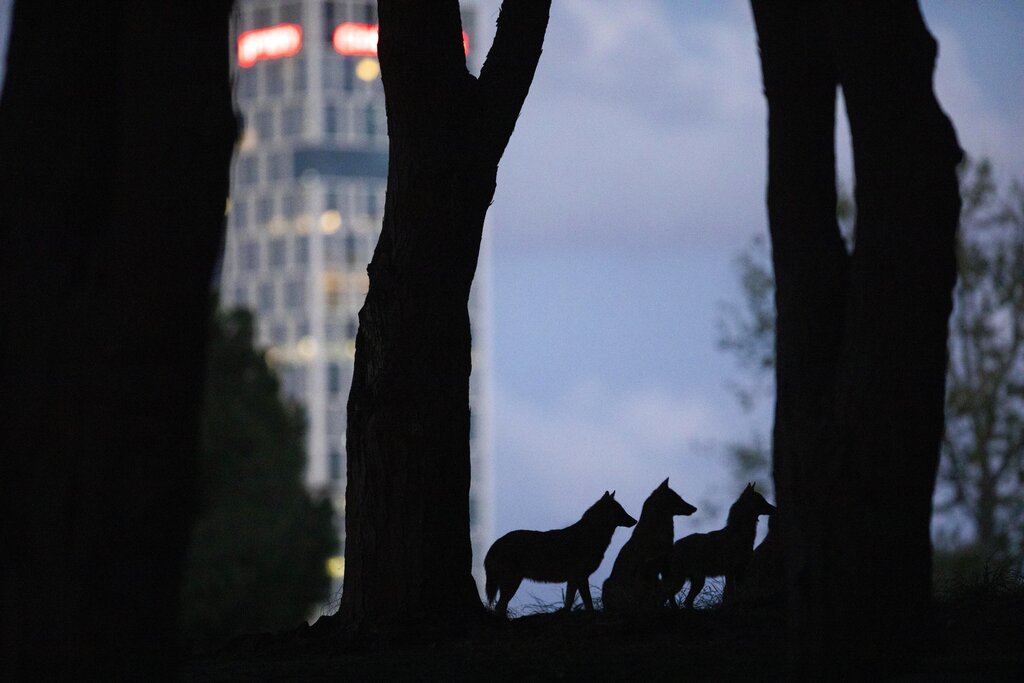Bad times have their own dream sequence. All that wildlife pouring onto city streets in a steady stream. The Arabian Sea flushed pink from thousands of flamingoes. Sometime in early March, the people of Siliguri spied the dhanesh, the oriental pied hornbill, within city limits. Actually a pair of them was spotted on the roof of a multi-storey building. It could have been a dream fluttering on the brink of wakefulness, sure to shatter any moment.
Mind you, this is all streaming through an altered perspective. It is almost as if a lockdown has been lifted and all inhabitants have been set free, and they are now headed for areas they have not set foot in for years.
It is as if some pandemic nearly swallowed this planet for a hundred years or more, and now, by some mysterious intervention that vile thing has been exorcised. And after countless generations, the peacock and the bison, the hornbill and the dolphin have come upon this unencumbered moment. Air itself can breathe easy; oxides of nitrogen and sulphur have come down. The trees are admiring of their own green, there is not much dust on their leaves. Humans call this experience glee. Yes, Earth is going into paroxysms of glee.
If anyone is romantic enough to believe that having experienced this pristine vision without the asking, the human race will hereafter change its ways, then I have to say that person is clueless about human behaviour. My fear is that once this lockdown expires, a wave of unbridled human activity will devour the last patch of green. That day there will be no one to question what new toxic vapours are mixing with the air we breathe, what pollutants are choking our rivers. That day the “GDP-above-all” chant will most likely mute the discerning and force the seeing to turn a blind eye.
When the Narendra Modi government first came to power, it touched the ground running with a slew of green clearances for hundreds of businesses. The move was symptomatic of the pressure it faced from the business community. Post the lockdown that old pressure will assume new and more terrible proportions.

A duck walks past statues of a rhinoceros and horse in front of the Orsay museum during a nationwide confinement to counter the Covid-19 in Paris Tuesday, April 14, 2020. (AP Photo/Christophe Ena)
A disquieting thought? Then try this. In the face of such doom why does it gladden our hearts to see this outpouring of wildlife where human civilisation ruled? What makes us cheer? Share photo evidence of Earth and its non-human creatures in bloom hundreds of times over on social media? Is this Gaia working on the human psyche? American biologist E.O. Wilson had believed in biophilia, which he defined as the urge to affiliate with other forms of life. Is biophilia a covert act of Gaia?
It is time now for me to speak directly to those whose optimism I might have jeopardised with this piece. I want to tell them that of his own free will and good sense man will never strive to make permanent the dream sequence. That would have to be a political decision.
What man can do is attempt to recognise the planet as Gaia — an entity by itself. It is only then that he will begin to realise that it is not the coronavirus that ails him. In fact, it is Gaia that is ailing. And what ails Gaia are deforestation, global warming and millions of undernourished humans of poor nations. A combination of these factors is the real disease, corona is only an agent.
Reckless industrialisation without a thought for the complex interactions of the components of the earth system has endangered the environment, and ironically, the first victims are those in whose lives this advancement has cast no light. Perhaps the human race will survive this pandemic, but in all likelihood it will be quite literally over the dead bodies of those shadowy figures of the first victims. And that will be the biggest tragedy of all.

In this Saturday, April 11, 2020 file photo, a pack of jackals eats dog food that was left for them by a woman at Hayarkon Park in Tel Aviv, Israel. With a lockdown against the coronavirus crisis, the sprawling park is practically empty. This has cleared the way for packs of jackals to take over this urban oasis in the heart of the city as they search for food. (AP Photo/Oded Balilty)
Never mind what will be. For now, let us return to the dream scenes unravelling. And rethink, using the altered perspective, hitherto accepted notions of disease and the diseased. Is the human race — or the industrial civilisation — to Earth what a disease is to the body? Is our planet diseased and does it want to purge itself of the virus that is the human race? From these questions are born other, newer questions.
When someone says “the human race will hereafter change”, then who is the someone? Is that someone a denizen of some other planet looking in on us? And if the viewer is an Earthling, a human, then what is his or her identity? Is it someone from the Global North, guzzling oil, living the accepted good life? Or is it that Adivasi youth returning from the jungles of Chhattisgarh with his bundle of firewood? When we say this planet is blossoming, what is the ideal we have in mind?
Ever since we can remember, man has altered his immediate environment for his convenience. You might say that termites do that too, and ants. And the beaver, which is a type of rodent, fells trees and uses the trunks to dam rivers. But even you will agree these are not a jot on the degree of change, the scale and the geographical expanse impacted compared to man and his doings.
There is that scene from the classic BBC documentary series titled The Ascent of Man. The opening scene shows a silhouette of a man standing atop a hillock and the voice of Jacob Bronowski saying: “Man is a singular creature. He has a set of gifts which make him unique among animals: so that unlike them he is not a figure in the landscape — he is the shaper of the landscape.” At some point, from being shaper, man has moved on to become destroyer of the landscape.
Nearly three decades after Bronowski’s utterance in 2000, scientist Paul Crutzen introduced the word “anthropocene”. It means the age of man. The period when man violated the bounty of this planet — soil, earth, air, water — and also altered Earth’s geologic character.
Here are some of the things that have jeopardised the very existence of the human race.
One. Post industrialisation, for the last 250 years, man alone has added to 48 per cent of the carbon dioxide content of the atmosphere. Average temperatures have also been climbing and today’s average is greater by 1.5 degree Celsius than what used to be the average 40 years ago.
Two. The invention of plastic, one of the most ubiquitous commodities of life as we know it. Micro plastics are microscopic pieces of plastic that pollute the environment. They enter the body of creatures of the sea. In recent times, scientists have even come across a new type of rock, plastiglomerates, that is a mix of plastic, basalt and organic debris.
Three. Deforestation. In this century alone, nine per cent of the planet’s forests has disappeared. Naturalists fear that by 2030, in one way or the other Earth will lose five per cent of its species, plants and animals, and man will be responsible for it.
In the early 1990s, futurist and inventor James Lovelock came out with his book, Gaia: The Practical Science of Planetary Medicine. The moot point of it is that Earth is a living entity and not some platform meant solely to host man, flora and fauna.
Lovelock called this entity, with all its living and non living inhabitants, Gaia. According to Lovelock’s Gaia hypothesis, the biosphere has a regulatory effect on Earth’s environment that acts to sustain life.
Not everyone in the science community embraced this concept. Nevertheless, this was a milestone and the beginning of the birth of a discipline called geophysiology or earth system science. The concept of Gaia ties in with the dream sequence of these terrible times. Lovelock also writes: “Humans on the earth behave in some ways like a pathogenic microorganism. We have grown in numbers and in disturbance to Gaia, to the point where our presence is perceptibly disabling, like a disease.”
What can be the outcome of this tussle between man and planet? Possibility 1. The planet gets rid of humans. Possibility 2. The planet somehow tolerates the presence of humans, and survives with reduced functionality. Possibility 3. Death of the entity that is Gaia, wherein all life forms vanish. Possibility 4. A symbiotic relationship among all concerned.
The truth is that human knowledge of the workings of the planet is incomplete. Lovelock once asked a group of scientists whether they could formulate a model to predict the consequences of wiping out the Amazon forests, especially the effect on global climate, before the forest actually vanishes. The scientists replied that it was impossible to predict considering the rate at which the forests were being decimated, as compared to the rate at which climate science was progressing.
It is a common and an arrogant thought that humans can climb out of any calamity with the help of technology. The earth system is a complex thing and we don’t know enough about it to come up with technology that might harness its mysterious ways. In such a scenario, what is the thing to do?
Lovelock had said, “If we fail to curb glo bal heating, the planet could massively and cruelly cull us.”
Idle imagination or semi-scientific prophecy? Whatever it might be, can we use it to interpret the ravages of the coronavirus as Gaia tightening the leash on errant humans? A virus that has tripped up the entire human race and suddenly all the technology at its behest is not enough to meet its challenge.

Flamingos are seen at NRI Wetland during a nationwide lockdown in the wake of coronavirus pandemic, in Navi Mumbai, Sunday, April 12, 2020. PTI











